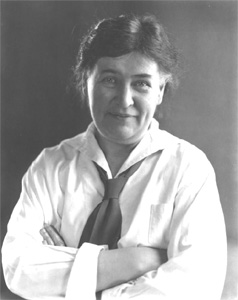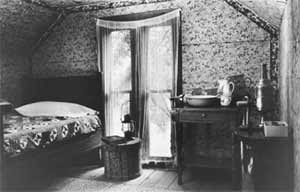Willa Cather was born on December 7, 1873, near Winchester, Va. She was the oldest of Charles and Mary Virginia’s seven children. Her father was a farmer and businessman; her mother a schoolteacher. In 1883, the family moved to Nebraska to join her Cather grandparents and uncle. This uprooting left her deeply homesick for Virginia. She later described her first reaction to Nebraska’s stark landscape as “a kind of erasure of personality.”
After farming for over a year, Charles Cather resettled the family in nearby Red Cloud, Neb., where they lived in town and her father dealt in real estate and insurance. In Red Cloud, the inspiration for Black Hawk in My Ántonia, Cather established the relationships with friends and neighbors that would be the most important sources for her writing. She listened to the stories of her immigrant neighbors from Bohemia, Denmark, Norway and Sweden and their struggles to make a living from the land and find acceptance from their American-born neighbors.
During this time, Cather became friends with Annie Sadilek, the model for Ántonia Shimerda. In an interview in 1921, Cather explained: “One of the people who interested me most as a child was the Bohemian hired girl of one of our neighbors, who was so good to me. She was one of the truest artists I ever knew in the keenness and sensitiveness of her enjoyment, in her love of people and in her willingness to take pains. I did not realize all this as a child, but Annie fascinated me, and I always had it in my mind to write a story about her.”
She dedicated the novel to two of her childhood friends, Carrie and Irene Miner. Carrie Miner is the model for Frances Harling and Mrs. Miner, for whom Annie Sadilek worked, is portrayed as Mrs. Harling. Cather’s grandparents, William and Caroline Cather, share many traits with Jim Burden’s grandparents. Blind d’Arnault was based on an occasional visitor to Red Cloud named Blind Boone.
Cather was taught at home by her grandmother and mother before starting school. She read widely in the classics, wrote and performed plays and delivered the valedictory speech at her high school graduation.
At age 16, she entered the University of Nebraska in Lincoln. She changed her college studies from medicine to classics when a professor, unbeknownst to her, submitted one of her essays to the Nebraska State Journal. The sight of her name in print inspired her to dedicate her life to writing. She reviewed music and drama for the Journal in her junior year, expressing strong convictions about art and artistry. After graduation, Cather moved to Pittsburgh to edit a magazine and continued to review drama and music.
During this period, Cather began her lifelong friendship with Isabelle McClung. She lived with the socially prominent McClung family and they visited Europe together. Europe was a revelation for Cather, a recognition of the themes from the European classics she grew up on and an appreciation of America’s possibilities.
She published her first book, April Twilights, a collection of poems, in 1903 and a collection of short stories, The Troll Garden, in 1905. In 1906, Cather moved to New York to write for McClure’s Magazine and was its editor from 1908 to 1911. While researching a McClure’s article in Boston, Cather met Sarah Orne Jewett, author of The Country of the Pointed Firs. Jewett died several months after their first meeting, but their short friendship provided Cather with crucial advice from an experienced woman writer. Cather, Jewett urged, should leave journalism if she wanted to be a novelist. Jewett told her, “You must find a quiet place…You must find your own quiet center of life and write from that.” Cather left McClure’s when her first novel, Alexander’s Bridge, was published in 1911.
A visit to the ruins of the Anasazi cliff dwellers in the Southwest made her rethink Nebraska and its native and immigrant cultures. She published her first Nebraska novel that year, O Pioneers, and felt that her career as a writer had begun. Her next novel, Song of the Lark (1915), expresses Cather’s passion for music and the role of the woman artist through the struggles of a singer and is partly set in Chicago. Its modest success resulted in the beginning of Cather’s efforts to guard her privacy, find time for writing and the things that nurtured her creativity.
In 1916, Isabelle McClung announced that she was going to marry violinist Jan Hambourg. Depressed by the news, Cather visited Red Cloud for several months and renewed her old friendship with Annie Sadilek Pavelka, now married and living on a farm with her many children. Returning to the East Coast, she began work on My Ántonia, published in 1918. My Ántonia had a modest financial success when it was first published. Literary critic H.L. Mencken said, “No romantic novel ever written in America, by man or woman, is one half so beautiful as My Ántonia.” Cather was happy with the novel and said it was “the best thing I’ve ever done…I feel I’ve made a contribution to American letters in that book.”
Cather took an active interest in the design of her books. For My Ántonia, she commissioned line drawings from the Bohemian-born artist W.T. Benda. Cather requested that the illustrations be simple pen and ink drawings that resembled old woodcuts.
Her next book, One of Ours (1922), was based on a cousin’s death in World War I. It was her first bestseller and won the 1922 Pulitzer Prize. For Death Comes for the Archbishop (1927), Cather visited New Mexico and worked with original sources for the story of 19th century priests. Shadows on the Rock (1931) again shows Cather’s masterful fictionalization of a particular place and time—Quebec through the mid-18th century.
Cather developed a painful wrist and hand condition while writing Lucy Gayheart (1935). It made writing very difficult for her until her death. Her last novel, Sapphira and the Slave Girl (1940), took place in 19th century Virginia and followed a 1938 visit to the places of her early childhood. Cather’s last years were marked by the death of Isabelle McClung Hambourg in 1938. Her dislike of modernity’s values increased. Cather’s conviction that celebrity led to loss of privacy, excessive wealth and time taken from writing also grew.
After her death at age 73 in 1947 of a cerebral hemorrhage, her literary executor destroyed many of her papers, including letters to and from her. Her will forbids publication of direct quotations from her surviving letters. Inscribed on her tombstone is a quotation from My Ántonia that reflects her artistic spirit: “That is happiness, to be dissolved into something complete and great.”
Sources
- Acocella, Joan. “Cather and the Academy.” New Yorker, November 27, 1995, p. 56–71.
- Grumbach, Doris. “Foreword” to Cather, Willa. My Ántonia. HoughtonMifflin, 1988.
- Lewis, Edith. Willa Cather Living. Alfred A. Knopf, 1953.
- Murphy, John J. “My Ántonia:” The Road Home. Twayne Publishers, 1989.
Content last updated: October 31, 2002



